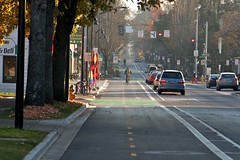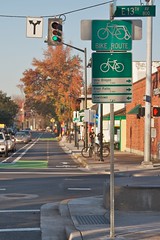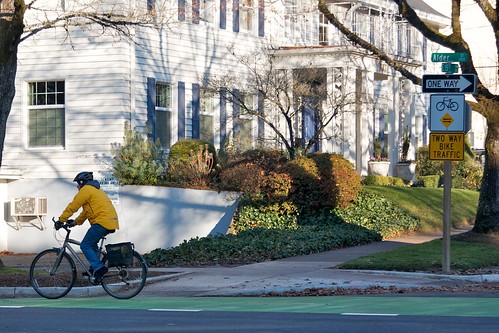
(Photos: Will Vanlue)
During a recent trip to Eugene, I had the pleasure of going for a bike ride with Shane MacRhodes, Program Manager of Eugene Safe Routes to School, and Bob Passaro, publisher of Eugene Bicyclist to see recent improvements in bicycle access around the city.
Despite seeing a lot of really great things (which I’ll share more of soon), nothing I saw was quite as impressive as the two-way cycle track near the University of Oregon.
The new cycle track, installed at the beginning of the school year on Alder Street (which runs north/south along the west edge of campus), is an example of how a street can be reconfigured to improve safety and the quality of experience for all road users. This specific cycle track was designed in a way that also maintained existing capacity for all modes of travel.
“Now that the cycle track has been in use for a full term of classes it’s a big hit. A group of students who enjoyed it so much that they started exchanging high-fives as they passed each other on bicycles. The trend caught on and became a regular sight on the cycle track.”
Previously on Alder, bikes had a curb-side bike lane in both directions. The bike lanes were separated in the middle by a one-way travel lane for motor vehicles. Most of Alder near campus consisted of just three lanes, but a few short sections of the street also had parallel, on-street parking spaces for motor vehicles.
Despite having dedicated lanes for bikes and motor vehicles, the old configuration of the street presented some serious safety concerns. In many ways Alder felt like any other one-way street to people in cars so they sometimes, naturally, weren’t expecting two-way bicycle traffic.
The old configuration of the street also meant that people had to drive their cars through a bike lane when they were turning off of Alder, in either direction, and whenever they parked their car on the street.

travel lane and parking for motor vehicles next to a two-way cycle track
The new lane configuration places a two-way cycle track on the east side of the street next to a one-way motor vehicle lane. Most of the motor vehicle parking has been retained as well, but it’s been placed between the cycle track and the motor vehicle lane.

bike trailer route.
The placement of parking accomplishes three things: it allows people to park cars without having to cross a bicycle lane, it gives bike traffic a buffer from auto traffic, and it allows cars to make a right at a red light without crossing the bike lane.
In addition to reducing the number of potential conflict areas on the street, the reconfigured lanes also help focus people’s attention at the unavoidable conflict areas, such as intersections, using some well-tested solutions.
At an intersection with a high-volume of cross traffic the city has installed separate signals for bicycles and for cars. Similar to the bike single at east end of the Steel Bridge, the bike signal on Alder eliminates the possibility (if everyone obeys the signal) of cars and bicycles colliding by allowing each mode to have its own turn.
It’s interesting to note that the bicycle signal uses a camera-based detection system which, from my brief experience, seemed to be more reliable and responsive than the more common induction loops.

even when you have the sun in your eyes.
All intersections benefit from green thermoplastic in the cycle track, indicating to people in cars that there’s a potential for bicycle traffic and giving people on bicycles the confidence to take advantage of their legal right of way.
These changes are very dramatic, both in their appearance and in how people now travel along the street.
MacRhodes told me about an initial resistance to the changes, even from some people who ride bicycles in the area. Apparently they were concerned about people on bicycles passing in opposite directions and colliding with one another. There was also concern that people in motor vehicles wouldn’t correctly interpret parking signs or traffic signals.
Now that the cycle track has been in use for a full term of classes it’s a big hit. A group of students who enjoyed it so much that they started exchanging high-fives as they passed each other on bicycles. The trend caught on and became a regular sight on the cycle track.
According to both MacRhodes and Passaro the cycle track is regularly filled with students, staff, and area residents on bicycles. My visit happened to be during the week after final exams so the cycle track, and the whole campus, was very quiet.
However, on two separate visits to the area, I saw a steady stream of people riding along the bright green tracks.
Here are just a few of the folks I saw riding on the Alder cycle track…



As someone visiting from out of town, unaware of the layout of Alder until I saw it in person, I can see why the cycle track has quickly become a big hit: it’s intuitive for anyone who needs to use the street for walking, biking, or driving and conveys a feeling of safety for all road users.
The cycle track is still new, and there may be unforeseen challenges ahead. Green thermoplastic, for instance, is known for cracking in Oregon’s winter weather.
If the cycle track maintains its current popularity and usefulness it will have accomplished something impressive: instead of attempting to modify people’s behavior to fit new traffic signals, this redesign of Alder Street simply encourages people’s natural behavior and provides a framework for orderly interactions between people using different modes of travel.
— Will Vanlue is a BikePortland staff writer. Read more of his work here. Contact him at will [at] bikeportland.org.

